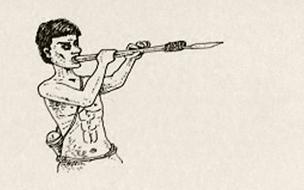Not too many styles of Filipino martial arts (FMA) teach techniques that deal with the projectile range. Among the few FMA styles that offer materials on this subject are the Sayoc system and the Pananandata system of Punong Guro Amante Mariñas Sr.
The Sayoc system is a multiple blade system that teaches how to deploy the blade as a projectile. Mariñas, meanwhile is known for teaching knife throwing. The advance phase of his balisong (Filipino butterfly knife) curriculum requires that the student be able to use the knife as a projectile.
Dealing with the projectile range was part and parcel of the training of ancient Filipino warriors. Various historical documents reveal of their adeptness in the use of many projectile weapons that includes primarily blowguns, bow-and-arrow and spears.
The Filipino term for blowgun is “sumpit” or sumpitan.” Antonio Pigafetta, the chronicler of Ferdinand Magellan has a graphic description of the early Filipinos’ use of the blowgun, it says, “Those people of Polaoan [Palawan] go naked as do the others: almost all of them cultivate their fields.
They have blowpipes with thick wooden arrows more than one palmo long, with harpoon points, and other tipped with fishbones, and poisoned with an herb; while others are tipped with points of bamboo like harpoon and are poisoned.
At the end of the arrow they attach a little piece of softwood, instead of feathers. At the end of their blowpipes they fasten a bit of iron like a spearhead; and when they have shot all their arrows they fight with that (Pigafetta’s Account 1521 Part II, 1898, the Shaping of Philippine History Vol. 2 no. 17, October 1998).”
This particular account of Pigafetta reveals an important thing about the war arts of the Philippines before the coming of the Spaniard and that is ancient Filipino warriors know how to function in all the phases of the combat continuum – from projectile range to hand-to-hand combat range.
Notice the part, “At the end of their blowpipes they fasten a bit of iron like a spearhead; and when they have shot all their arrows they fight with that.”
During my visit to Sabah, Malaysia in 2008, I was amazed to discover that the type of blowgun that Pigafetta described 487 years ago was still in existence in that country. It is interesting to note too that Sabah was once a part of the Philippines.
This wooden blowpipe resembles a tapered escrima hardwood stick with a metal spearhead attached to the end. I would opine that it is more efficient as a stabbing weapon than as an impact weapon at close range.
There were numerous accounts on the participation of native archers in various Philippine wars from Spanish colonial times up to the Japanese occupation. My late uncle, USAFFE (United States Army Forces in the Far East) Sergeant Penitente Apolinar escaped from the Death March, from Bataan to Capas, Tarlac during World War II through the aid of an Aeta archer.
He had a clear recollection of the bow-and-arrow (busog at palaso) of the ethnic warrior. He said that despite his size and strength, he couldn’t match the ease by which the Aeta pulled the bowstring. He said that a Japanese sniper later killed that intrepid native archer.
The general term in Filipino used for spear is “sibat.” On the use of this weapon by ancient Filipino warriors, the late FMA scholar Pedro Reyes wrote, “But the Filipinos threw javelins with great accuracy in their battles at the sea, pieces of hardwood sharpened at both ends that were about 30 centimeters long. On the land, they threw disposable spears of bamboo like some of the bolomen of World War II.
In fact the spear was the favorite weapon of the Visayans and a warrior may carry a personal and elaborately decorated spear, but the Visayans threw these expensive spears only when they could recover them easily (Influence of Filipino Culture on Arnis, Rapid Journal Vol.7no.3).”
Because of its abundance in the archipelago, bamboo is often used by Filipinos to create impromptu spears either for combat or hunting games. With one stroke of the bolo, they can create a vicious point out of the business end of a bamboo. The Tagalog term for this bamboo spears is “buho.”
Such spears were heavily used by the warriors of Lapu-lapu against Magellan in the Battle of Mactan on April 27, 1521. Again, a quote from Pigafetta’s account reads, “An Indian hurled a bamboo spear into the captain’s face, but the latter immediately killed him with his lance, which he left in the Indian’s body.
Then, trying to lay hand on sword, he could draw it out but halfway, because he had been wounded in the arm with a bamboo spear. When the natives saw that, they all hurled themselves upon him. One of them wounded him on the left leg with a large cutlass, which resembles a scimitar, only being larger.
That caused the captain to fall face downward, when immediately they rushed upon him with iron and bamboo spears and with their cutlasses, until they killed our mirror, our light, our comfort, and our true guide.”
Another ancient Filipino weapon fashioned out of bamboo is the bagakay. Bagakay is a bamboo dart measuring about six inches thrown at an enemy at close quarters.
These darts were generally thrown five at a time to increase the possibility of hitting the target. The term bagakay on certain instances may also connote a long bamboo lance.





















